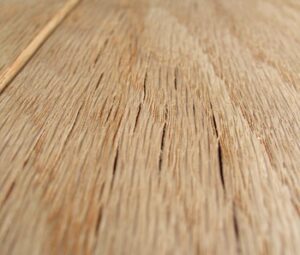Problems with Green Lumber – Part 3: Stain and Checking

Chemical Stains
Stain is particularly problematic in the south during warm, humid months. The frustrating part of stain control is that sometimes the stain, as well as insects and/or fungi, is present in the tree so regardless of how we process the lumber, we will still have stain to contend with. This is because when a tree is harvested some wood cells remain active for months, especially in warm weather (over 50 F). These cells are ray parenchyma and their job is to convert sugars and starches into chemicals that will oxidize, in the presence of enzymes, into dark colored chemicals. This results in stained wood at the end of the drying process and is known as sticker stain, brown stain coffee stain, and gray stain.
The majority of the chemical reaction occurs when the wood is green and includes log storage before sawing. However, the stain will not appear until the wood is dry. The sapwood region is where most of the ray parenchyma cells are active and is most prone to chemical stains. Lumber and logs that have been mishandled when green are often characterized with water stains or a gray appearance instead of a fresh appearance. Mishandled logs often have end stain, which is a gray stain that extends a few inches at the ends of the lumber. Rapid processing of a freshly cut log will yield lumber that is brighter and whiter in color.
Oxidative Hardwood Stain
Some hardwoods can develop deep yellow to reddish-brown discolorations on the surface when exposed to air immediately after sawing or peeling. Species such as cherry, birch, sycamore, oak, maple and sweet gum are some examples. Stain can develop in oaks, birch and maple during air-seasoning and is greatest at the point where the sticker contacts the lumber. Therefore, the term sticker stain is often used in such instances. This stain will not appear in lumber that is immediately kiln dried after sawing and is less present in the winter. A related gray stain in several southern oaks also is oxidative in nature.
Mineral Stain
The term mineral stain has been loosely used by the lumber industry to denote stains of various kinds in hardwood lumber regardless of their origin and is not necessarily a problem with green lumber. This stain is most common in hardwood (both sapwood and heartwood) in the Northeast and Lake States. The stain is variable in occurrence and may appear as streaks or as a broad discoloration. Mineral-stained wood is often denser and harder than normal wood and will twist and warp when dried if severely stained. The lumber will tend to split when nailed and may be less suitable for construction. Researchers commonly attribute the onset of mineral stain as resulting from abnormal cell physiology occurring from wounds caused by insects, animals, weather, or logging. Differences in the occurrence of mineral stain have been identified among trees of the same species at different geographic locations with different soil characteristics.
Iron Stain
Iron stain is not a problem confined to green lumber and can be recognized as a dark purple or black stain that develops in the sapwood and surface of wood when sawn with an iron blade. Species that are susceptible are birch, cherry, sweet gum and oaks. Iron stain can also occur around nails in softwood lumber. The use of steel wool in sanding combined with a water-based finish can cause severe iron stain on dried wood surfaces. Iron stain can be removed by saturating the stained area with a mixture of oxalic acid (one pound per gallon of hot water) and allowing the solution to soak into the wood for several minutes. The area should be rinsed thoroughly and allowed to dry before refinishing. Since many iron stains are caused by a fastener, remove the fastener before applying the oxalic acid solution to the wood. Inspect all other fasteners to make sure they are noncorrosive. Remember to use caution and avoid skin contact with oxalic acid. It is toxic and is dangerous if ingested.
General Stain Control
The best control for most forms of stain is proper handling during harvesting and seasoning. It’s possible for a sawmill or user to handle the lumber properly but still have stain that developed in the log before it was milled. Logs should be quickly transported to the sawmill and not allowed to stay in the forest for weeks, especially during wet summer months. If a log is not to be processed in the near future, store it in a pond or under a sprinkler system to create an anaerobic environment. Quality lumber should be treated with an anti-stain fungicide within 24 hours of sawing. Don’t store treated lumber in the rain and risk the possibility of diluting surface retention levels. If lumber is to be stored, do so on stickers made of heartwood or preservative-treated wood. Also, use proper piling practices that allow for good air flow.
Surface and End Checking
Lumber from stored logs and lumber that has been stored after sawing are much more likely to develop surface and end checking than freshly sawn lumber. We can reduce the risk of checking by drying the wood more slowly. However, this will also increase the risk of stain and discoloration. Stored wood should always be end coated with a paraffin-based wax to minimize end checking
Meet the Author
Dr. Todd Shupe is the President of Wood Science Consulting, LLC. He is a well-recognized expert on wood forensics, wood preservation, wood decay and degradation, and wood species identification. He has a broad background in new product development, quality management, and marketing and sales in both the public and private sectors. For more information please visit DrToddShupe.com.
We welcome your comments below.
Thank you for visiting. We trust that you have enjoyed reading our articles.
Liked this post? Read more below or search for more topics . . .

